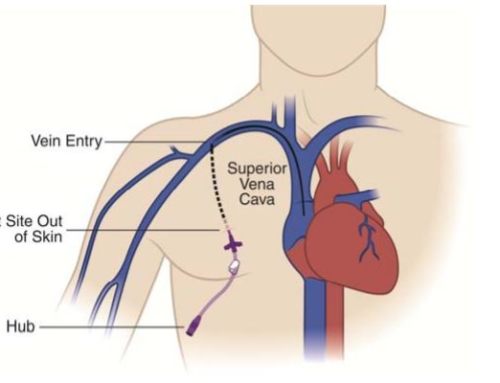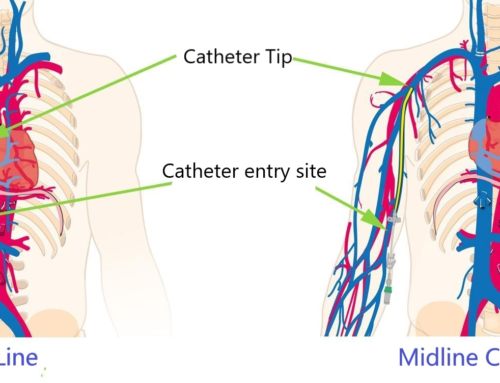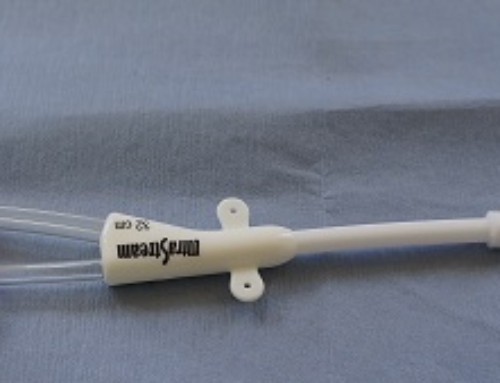Table of Contents
What is a portacath or Chemo port?
A portacath is a medical device that is used to administer medications or fluids into a patient’s bloodstream. It is a type of central venous access device, meaning that it is inserted into a large vein in the body, usually in the chest or neck area, and provides a way to access the central veins that carry blood to the heart.
A portacath consists of a small, thin tube (catheter) that is inserted into a vein and passed through the chest or neck until the tip of the catheter is positioned in a large vein near the heart. The catheter is then secured in place with suture threads and covered with a small, thin layer of tissue called a fascial layer. The end of the catheter that extends outside the body is attached to a small, round, disk-shaped port that is placed just beneath the skin.
The port has a septum, or thin membrane, that can be punctured with a needle to access the central veins through the catheter. The port is typically connected to a length of tubing that is attached to an intravenous (IV) bag or other medication delivery device.
Portacaths are often used in patients who require frequent or long-term intravenous treatment, such as chemotherapy or parenteral nutrition. They offer a convenient, less invasive alternative to traditional IV lines, which require a new needle to be inserted into a vein each time treatment is needed.
Port-a-cath also referred to simply as a Portacath and chemo port (A chest port used for chemo) is an implantable venous access system. Portacaths (Chemo ports) are one of a set of long term venous access options. The intravascular segment is made of similar material to Hickman catheters and other similar tunneled catheters. The port itself has a thick injection membrane which is housed in a titanium or plastic case, which is surgically implanted under the skin.
The chemo port is then accessed with special non coring huber type needles through the skin. These ports allow patients to swim and bathe which is restricted with other tunneled central venous catheters such as broviac or hickman catheters. Implantable port-a-caths (Chemo ports) allow for central venous access that can be used by patients who need long-term venous access for various treatments or for administering fluids and medicines. Common locations for placement of portacaths/chemo ports include either the chest or on the arm.

Portacath (Chemo port) indications
The Port-a-cath (Chemo port) is recommended in several situations;
- Frequent administration of fluids or medications for long-term
- For chemotherapy in cancer patients
- Obtaining repeated blood samples
- Delivering total perenteral nutrition (TPN)
- Delivering coagulation factors in patients with hemophilia
- For administering contrast agents in patients requiring repeated contrast enhanced imaging who may not have easily accessible peripheral veins
- For administering analgesics to patient with chronic pain
A port-a-cath (Chemo port) is made up of three parts, the port itself, venous catheter and a catheter connector. Let us discuss one by one the role of each of these parts.
Port- is the reservoir compartment or a small chamber that is sealed at the top with a septum. The site of the port which is punctured is made of resilient silicone. The septum can be punctured many times with a non coring Huber type needle many times. Every time the chemo port is accessed the fluid that is in the port is discarded. This fluid is generally heparin but can also be alcohol in patients who are allergic to heparin or even saline. The heparin lock is meant to keep the catheter free of clots. Once accessed with the needle through the skin the fluid can be administered or blood drawn. Chemo ports are located under the skin either by visual inspection or by palpation (Feeling for slightly raised rubber markers around the septum). Chemo ports come in multiple different styles and can be low profile to allow for discreteness or placement in the arm and they can also have 1 or 2 lumens or septum to allow for administration of 1 or two medications simultaneously
Catheter– is a flexible tube/catheter generally made of silicone and similar to that used in most other tunneled central venous catheters which commonly runs from the port portion under the skin in the chest and is tunneled to the venotomy (Site where the vein is entered) at the base of the neck into the jugular vein or subclavian vein. After entering the vein the catheter tip generally terminates in superior vena cava/right atrium to allow for mixture of the injected drugs into the high blood flow region near the heart.
Connector– is basically a catheter connector that connects catheter to the port. This could be made of titanium, titanium and plastic or entirely plastic.

Port-a-cath (Chemo port) Placement And Removal
The placement of port-a-cath / Chemo port involves a minor surgical procedure, which allows for placement of the port and catheter completely inside the body with the access port placed under skin where it can be felt to allow for easy puncture/access through the skin.
The procedure is performed under local anesthetic such as lidocaine using imaging guidance (X-ray and ultrasound). A skin incision spanning about 3cm is made on the chest wall for the port and another smaller incision is made on the neck. The neck incision is very small 1/2cm or less which allows access to the vein usually the jugular vein or subclavian vrin and generally does not require to be sutured. Some centers will use sutures but these sutures are generally the absorbable type. At LA Vascular this venotomy (neck incision to allow access to the vein) is closed with dermabond and steristrips allowing for decreased scar formation and avoiding keloid in those who are prone.
Likewise, removal of this implantable venous catheter requires a small incision so that it can be removed gently from neck and chest. This might require local anesthesia.
Port-a-cath and Chemo port care
This type of implantable venous access catheter requires minimal care as compared to other catheters, since it is completely positioned under the skin. However, there are still a few guidelines that should be followed when it comes to port-a-cath/chemo port.
Cleaning the site- A dressing covers the needle (if placed) and the portal site so that both are secured in their place. It is very important to keep the dressing dry and clean as a port site infection usually requires removal of the port. We recommend daily checks of the chest port site to assess for any redness, swelling, bruising or tenderness which may indicate an infection. If any of these signs are present, contact your clinician immediately.
Flushing- Chemo ports are generally primed with heparin to limit clot propagation. alternative exist for patients who have allergies to heparin and they include alcohol or simple saline. Heparin is used in the vast number of cases given its benefits of avoiding clotting. Every time the port is accessed the heparin lock is removed from each lumen (Two lumens for a double port and 1 lumen for a single port). Once this heparin lock is aspirated and discarded the port can be flushed with saline and medication can be administered.
Restricting Activities- While it’s understood that vigorous activities should be undertaken with caution, it is best to consult your doctor before undertaking any routine as some providers have separate recommendations. Generally however activities like swimming which are not allowed with most tunneled hemodialysis catheters can be undertaken once the port has been in place and the incisions have healed. Despite this contact your provider with questions as some patients who form wounds over the puncture site can be at greater risk for infection from simple activities such as swimming or showering .
Make sure you are familiar with the basic care techniques of port-a-cath/chemo port and discuss any questions with your provider. In addition to the above the following guidelines are universal for ports;
- Once inserted, don’t tilt the access needle as it can damage the diaphragm of the port or tilt the port entirely or break the needle in the port
- Needle or other tubing attached to the chemo port should not be left open to air as an air embolus is a life threatening complication that can occur in this setting
- If the fluid being injected does not flow freely or causes pain or swelling, stop immediately and call your doctor. The port may have fractured or malfunctioned
- Most importantly, any change in the appearance of the site around injection should be reported immediately.
Port-a-cath (Chemo port) complications
Much like other devices that are implanted, port-a-cath/Chemo ports have potential complications. The complications can occur during placement, after placement or during removal the port have been reported in the literature.
Chemo port complications during placement
- Pneumothorax can occur and has been reported especially in cases where ultrasound imaging is not used during the venous access portion of the procedure. the reason for this is that the lung apex comes very close to the subclavian vessels which are sometimes accessed for placement of these catheters.
- Arterial injury a common problem prior to the wire availability of ultrasounds this complication has become rarer. It can occur because the subclavain artery runs close to the vein and can be inadvertently punctured leading to a hematoma.
- A bacterial infection is a complication that can occur during chemo port placement or after. whether due to an immunocompromised state in most chemo patients or poor hygiene this complication needs to be addressed urgently as sepsis or systemic infection can occur as a result.
Chemo port complications after placement
- A bacterial infection is a complication that can occur during chemo port placement or after.
- Thrombosis is the complication that can occur but can also be avoided by heparin lock and regular catheter use/maintenance
- Fibrin sheath formation is a complication that can occur with all long term central venous catheters. It generally results in the catheter/port being able to be flushed but not aspirating. This occurs because of the formation of a matrix of cells and debris which coalesces and forms around catheters. If suspected by clinical history and repeated issues with aspiration the catheter can be stripped (groin venous access is obtained and a snare is sent to grab and strip the fibrin sheath off of the catheter)
- Pinch off syndrome is a complication that occurs when the catheter which passes through the vein is compressed between the first rib and the clavicle, causing an intermittent (On and off again) mechanical occlusion for both injection and withdrawal/aspiration of the port or central venous catheter.

Chemo port complication during removal
- Fragmentation of the port catheter and embolization of fragments generally to the lung can occur. This is a dreaded complication but is uncommon and generally preventable.
- Chemo port site infection can occur even after removal and will require long term antibiotics and packing of the port site.





how common is it for piece of portacath to break off and end up in the atrium.